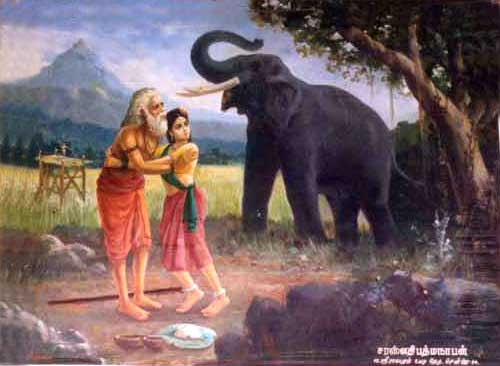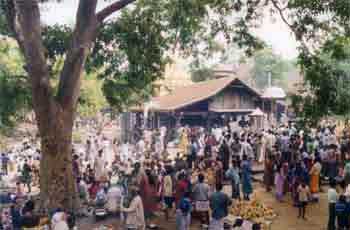
|
|||||||||||||
|
| |||||||||||||
The Story of KataragamaFrom the 1922 diary of the Government Agent, Uva Province, Mr. R.A.G. FestingThe story of Kataragama is perhaps worth repeating as I had not seen it detailed in any of the diaries I have read. As told to me—though there are probably different versions, it is as follows:
Kataragama was living in India with his wife Tevanai, with whom he had a 'tiff'. He left her and went to Ceylon landing at Dondra. Thence he went to Veddahundkanda — a hill above Kataragama—where he lived alone. One day out hunting he met Walliamma, the adopted daughter of a local Veddha. He proposed marriage and she refused. Thereupon he went and consulted his brother Ganesha and asked for his help. Next day he appeared as an old Brahmin before Walliamma and asked for food. She gave him some but he said he could not eat it unless he had a drink of water to wash it down. So she agreed to show him the way to the well. On the way he asked her if she was not afraid of living alone in the chena while all the men were away hunting. She said she was afraid of nothing except elephants. Immediately Ganesha appeared as an elephant and Walliamma clung to Kataragama asking him to protect her (a most amusing fresco of the scene). He said he would do so if she would marry him. She agreed and the elephant disappeared. So Kataragama brought her back to the chena. On their return her family and friends (Veddhas) rushed out to attack Kataragama whereupon he turned himself into a tree. The Veddhas were proceeding to cut down the tree when at the first blow blood gushed out, so the Veddhas thereby knew him to be a God and agreed to the marriage. Thus Kataragama and Walliamma lived together happily for many years. After a while Thevanai being tired of being a grass-widow sent Muttulingam Sami—Kataragama's teacher—and a man called Mohamed Navi to search for Kataragam. They searched for a long time and were giving up the task as hopeless when one day Muttulingam Samy found that his opium pipe, which he had left behind the previous day, had been smoked. By this he knew that Kataragam must have done it and that he could not be far off. He was then soon found and was asked to return to India. At first Kataragam consented but afterwards refused when he was told that Walliamma could not come too. Kataragam however persuaded Muttulingam Samy to stay behind, but Mohamed Navi returned to India and betrayed Kataragam's whereabouts to Thevanai. Thevanai came forthwith to Ceylon and Kataragam built a Kovil for Muttalingam Samy and a mosque for Mohamed Navi on either side of Walliamma's Devale. And now when the perahera conducts Kataragam to Walliamma's shrine there is a furious bell ringing and beating of drums and other loud noises in Thevanai's shrine to drown Thevanai's cries—or as others say to distract her attention. The noise would do either easily! It is curious how the part of Mohamed Navi is dragged into the story so as to give the Mohamedans a place in the worship. But they have to "take a back seat" as owing to Navi's betrayal of Kataragama no Mohamedan is allowed to appear within the temple precincts during the perahera under penalty of being beaten.
Sella Kataragama1st August: I think this Kataragama festival must be a relic of Veddha worship. The traditional connexion of Veddhas with the place eg that they adopted Walliamma; that in early days Veddhas did the work of Kapuralas and the name of the hill above where Kataragama is supposed to have lived—Veddha-hun-kande of Veddha-siti-kande all point to a Veddha origin. Parker in his Ancient Ceylon notes that rock-hills were often connected with the Veddha God-Gale Deviyo and it is quite likely that the Kataragam worship was originally of Veddha descent and that the Kataragama story was imposed by Tamil invaders on a spot already sacred.
|




